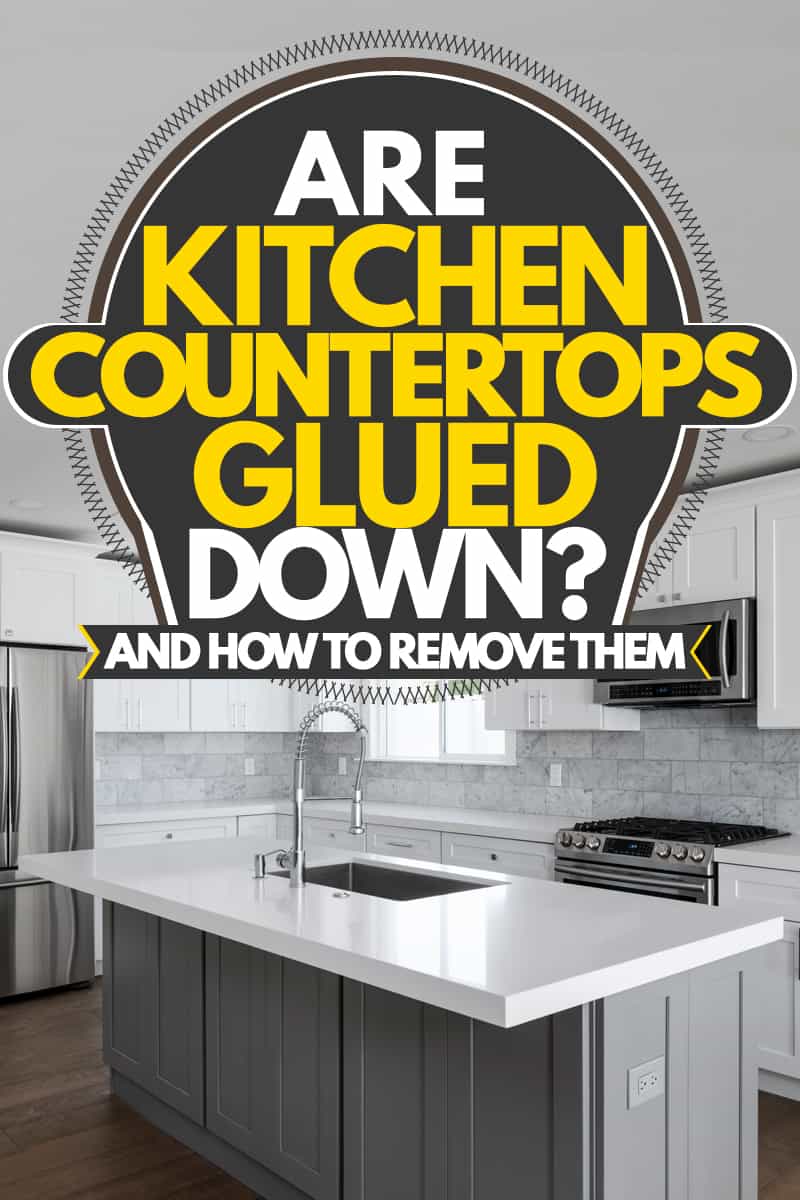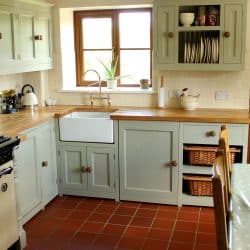It's finally time to remodel the kitchen, but how do you remove the old countertops? Are they glued down? We've done the research and compiled a step-by-step guide to save you time.
Countertops are typically adhered to the cabinets and walls using caulk or silicone. In some cases, they also have screws or other fasteners holding them in place from underneath. To remove your glued countertop, follow these simple steps:
- Prepare your workspace.
- Disconnect plumbing, electric, and gas.
- Remove your plumbing and fixtures.
- Loosen the adhesive.
- Unscrew the countertops.
- Pry the countertops up.
- Remove the old countertops.
This list covers the basics, but there is more to know about each step. We have some tips to make the whole process go a lot smoother. Keep reading to find a list of tools and equipment you will need, and to learn some tricks to make your project easier.

How To Remove Kitchen Countertops
Tools and Materials Needed
- Safety Glasses
- Work gloves
- Boxcutter knife
- Putty Knife
- Wrench
- Pry bar
- Screwdriver
- Caulk softener
- Container to catch water
Good safety glasses are necessary for every big project.
Click here to see these safety glasses on Amazon.
These work gloves will be sure to provide protection during many projects.
Click here to view these work gloves on Amazon.
This two-pack of utility knives should speed up the process.
Click here to see these on Amazon.
A plastic putty knife may not hold up to this task, find a strong metal putty knife lie this one:
Click here to check out this metal putty knife on Amazon.
This set of plumber's wrenches is sure to include whatever size you need.
Click here to see these wrenches on Amazon.
Make sure your pry bar is strong enough to withstand the heaviest countertop material.
Click here to check out this pry bar on Amazon.
A good drill will help you remove those screws quickly.
Click here to see this Black and Decker drill on Amazon.
Caulk softener is essential if you want to avoid any damage, click here to view this highly-rated softener on Amazon.
Click here to view this highly-rated caulk softener on Amazon.
Step 1: Prepare Your Workspace
Clear the area as much as possible to provide yourself with plenty of space to work in, and don't forget to empty your lower cabinets. Lay down a tarp or plastic to protect the floor and anything else nearby that you don't want to get scratched or scuffed. Get all of your tools together, and don't forget your gloves and protective eyewear.
Step 2: Disconnect Plumbing, Electric, and Gas
You will need to turn off the water valve leading to the kitchen sink. Shut off the fuse or breaker to the area, and cover any nearby outlets as an extra precaution. Also, be sure to turn the emergency shut off valve for your gas line if you have a gas stove. Be careful when handling utilities like these, and always double-check that they are shut off before you begin any work.
Step 3: Remove Plumbing and Fixtures
Remove the faucets and plumbing passing through the countertop, including the sink. Have a large container or bucket ready to catch any remaining water in the lines that may leak out. To remove the sink use your putty knife or boxcutter to scrape off any excess caulk, then cut around it. You may want to apply some caulk softener if the sink still shows resistance, but typically it can be gently pried up and pulled out at this stage.
Step 4: Loosen the Adhesive
Start by using your putty knife or boxcutter to carefully remove any excessive caulk around the countertop where it meets the cabinets. After you remove the excess caulk apply the caulk softener and let it sit for one hour. Use your putty knife to cut the caulk between the countertop and the wall or tile, gently wiggle the knife to loosen the seal. Use the pry bar to gently pry at the edges of the countertop until you start to feel the adhesive give way.
Step 5: Remove the Old Countertops
Look underneath your countertops to see if they are held in with any screws, brackets, or other fasteners, and make sure to remove any you find. After you remove the fasteners, you should be able to lift the countertop off and remove it completely. Make sure you have an extra set of hands if the countertops are large or heavy.
How to Remove Countertop Trim?
The method for removing the trim from your countertops will differ depending on the type of trim you are working with and how it was applied. Whether you have wood trim or metal trim it is most likely applied using brads or finishing nails, so you may be able to gently pry the trim off. If the trim has been glued in place it will be more difficult to remove without doing any damage to the trim, the counter, or the cabinets, prying with a putty knife or a prybar is still the best removal method.
Can you Replace Countertops without Damaging Cabinets?
Yes, as long as you are very careful you can certainly remove your countertops without doing any damage to your cabinets. Make sure you have removed all the fasteners underneath the countertop before you begin prying on it. Be very gentle when using your tools. If you can manage to remove the countertop without any damage you can always re-sell that to help balance your remodeling costs too.
What is the Cheapest Way to Replace Countertops?
Doing the work yourself will help to cut costs, and to take it a step further you could even try your hand at crafting your own countertop. There are some great do-it-yourself countertop ideas out there and some of them are fairly easy and quite beautiful. If you're not the type for DIY projects, check your local Craigslist or Facebook marketplace to score some great deals. The least costly pre-fab countertop material on the market is laminate, and it can be purchased for as little as $5 per linear foot.
Is it Hard to Remove Countertops?
No, removing countertops can be very simple. As long as you are prepared with the appropriate tools for the job you should not have a hard time. Having a few extra people around to help with the heavy lifting is a good idea. As always use extreme caution when working with utilities and tools.
How Long Does it Take to Remove Kitchen Cabinets?
For an average size kitchen, it will take about 25 to 30 hours of labor. This estimate varies greatly depending on many factors like how many people are on the job, and the size of the kitchen. When removing cabinets there is also a chance to discover things like mold or water damage, these types of issues need to be addressed immediately and can end up adding days to the project.
How do you Remove Glued Down Granite Countertops?
To remove granite countertops that are glued down, you can follow the same steps listed above. Make sure to check underneath the countertops for screws. For countertops made of granite and other heavy materials, you should have 3 or 4 extra people to help with the prying and lifting. Click here to read a post explaining how granite countertops are sealed.
How Much Does it Cost to Replace a Kitchen Countertop?
According to the information available online, the average cost to replace a kitchen countertop falls between approximately $1,500 and $4,500. Countertop materials can range between $1 and $190 per square foot, so your choice of material has a large impact on the total cost of the project. Doing the work yourself will also save you loads of money.
Should I Empty Cabinets Before Installing Countertop?
Yes, you should empty your cabinets before removing old countertops or installing new countertops. Leaving your belongings in the cabinet increases the risk of damage occurring. Emptying your cabinets will also give you more room to work, as you will need to get underneath the countertop to check for fasteners.
Can You Remove Kitchen Cabinets Without Removing Countertop?
This depends on how your countertop was originally installed. In most cases, it is not possible to remove your cabinets without first removing the countertop. Follow this guide and use caution when removing the countertop, and you may be able to reuse it with your new cabinets. Be very careful not to crack or chip the countertop when prying it up. You could also consider refacing your existing cabinets to avoid removing the countertop.
Conclusion
Removing your countertops may seem like a daunting task, but as long as you follow these tips, your remodel should be a snap. Remember to have fun with this project, remodeling is always an exciting process. Make sure to research what kind of new countertop is best for you, we have some great links below to get you started.
Additional Reading:
You may be interested in our blog post "How Much Do Butcher Block Countertops Cost?"
If you're considering epoxy countertops, check out our post "Are Epoxy Countertops Heat Resistant?"










![An ultra modern kitchen with a granite countertop, gray appliances, and wooden vinyl flooring, How to Paint Granite Countertops [15 Steps Guide]](https://kitchenseer.com/wp-content/uploads/2020/10/An-ultra-modern-kitchen-with-a-granite-countertop-gray-appliances-and-wooden-vinyl-flooring-250x250.jpg)


